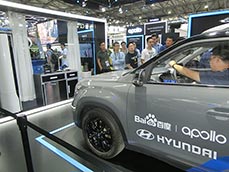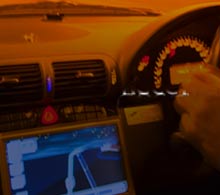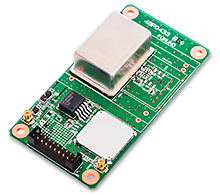Articles for ITS market CES Asia Report 2108
Both CES America and CES China shows were heavily influenced by the automotive industry.
CES Asia (June 13th-15th, 2018) was held in Shanghai New International Exhibition center, the between Shanghai city and Shanghai Pudong International Airport.
CES (Consumer Electronics Show) is the world's largest consumer electronics and IT trade fair held in January, every year in Las Vegas, Nevada, USA. While the Asia version CES is held in Shanghai, China.
The scale of the CES Asia was only a quarter the size of the CES in Las Vegas, but it was crowded with visitors from all over the world. The majority of the CES exhibitions revolved around the automotive industry. This trend is similar to CES in Las Vegas. In the past five years 3D printers, wearable glasses, wearable watches and VR (Virtual Reality) technology were the major exhibitors. However this year automotive manufacturers easily overwhelmed those industries. Both in Las Vegas and Shanghai I felt CES's leading influence was driven by the automotive industry.
Influence of NEV (New Energy Vehicle) regulation becomes clearer
The automotive manufacturers at CES Asia 2018 included outstanding exhibits from companies such as Daimler (Germany), General Motors (GM, America), Honda (Japan), Hyundai and Kia (Korea), and Viton (China).
From 2019 the Chinese government will implement a new energy vehicle (NEV) policy that mandates and obligates every automobile manufacturer sell a certain number of EV automobiles. The NEV regulation is based on the Zero Emission Vehicle (ZEV) regulation law that California state in the USA has been implementing since 1990. It was enacted as a form of technical cooperation between the Chinese government and California state government. Therefore the contents of the NEV and ZEV regulations are similar. The conversion factor details are based on the degree of electrification such as EV, plug-in hybrid car, fuel cell car, etc. By virtue of these categories and number of credits calculated, the number of electric vehicles sold is effectively mandated. Specifically and according to the NEV regulation, our target is 10% of the domestic demand in China in 2019 and 12% in 2020.
Viton was born during the Chinese EV bubble economy. They are trying to make cars similar to smartphones.
Based on the NEV regulation the EV bubble economy has occurred in the Chinese automobile industry and many EV start-up companies are well positioned to become winners.
Among them, Viton is very famous. Engineers from Germany BMW and others founded and launched Viton in 2016. They located their headquarters, development functions and assembling factories in Nanjing, Jiangsu. They have technology development in Munich Germany and software development in Silicon Valley in the USA. They will start mass production at the Nanjing factory in the second half of 2019. It will be a 5-door crossover car called "Embite". Key features are the Human-Machine Interface (HMI) which has a 1250 millimeter width and a 250 millimeter height located in front of the driver's seat. The power system data such as speedometer, navigation, and even SMS text are collectively displayed here. The Viton’s executives appealed to nearly 1,000 audience members and noted "We are trying to make cars become smartphones" in the keynote speech at CES Asia.
Chinese company Baidu is preparing to open their source of autonomous driving system project named “Apollo”
 Explanation diagram of open platform in Baidu Apollo program
Explanation diagram of open platform in Baidu Apollo program
 Explanation panel of cyber security measures in the Apollo plan
Explanation panel of cyber security measures in the Apollo plan
 Hyundai and Baidu Demonstrate DuerOS for Interactive Voice Recognition
Hyundai and Baidu Demonstrate DuerOS for Interactive Voice Recognition
To cooperate with automobile manufacturers development great attention is currently on Baidu, China's leading IT company project called Apollo. This project refers to the autonomous driving platform announced in the spring of 2017. Baidu is not well-known in Japan and people call Baidu the “Chinese Google”. The founder of Baidu attended Stanford University in the USA studying search engine technologies, etc. almost simultaneously while the founder of Google was studying the same subjects. After returning to Beijing the founder started providing search engine sites and digital maps online. They now have a large-scale database and facility on artificial intelligence (AI) research and are becoming a central source in the Chinese IT industry.
More than 200 companies, including international car manufacturers such as Honda and Hyundai have already joined the Apollo Consortium in the Baidu. The Apollo program is characterized as open sourcing at each technical layer of mass production for autonomous driving operations. DuerOS is their own standard OS for sensors such as cameras, millimeter wave radar, laser radar, image recognition software and cyber security. Medium-size buses and automatic delivery vehicles operating at autonomous driving level 4 with interactive voice recognition have already been launched by them. Regarding DuerOS, Baidu announced a technical alliance with Hyundai in 2017 and the exhibition was demonstrating DuerOS incorporated in Hyundai's multipurpose vehicle. Baidu already has success with a product that interfaces into a large 17-inch HMI installed in the car that controls air conditioners and audio in their house. As a competitive technology to Amazon “Alexa” and Google “Google Voice” their goal is to become the “de facto” standard in China.
Also, “Alibaba”, the leading IT company in China unveiled a worldwide technology using Bluetooth mesh, a new Bluetooth standard for collaborating home electronics and other devices. Alibaba aims to become the “de facto” standard by distributing a dedicated semiconductor chip at a low price. However they did not disclose any cooperation with the automotive industry at this time. As shown above, CES Asia exhibitors are supporting the development of EV and autonomous driving as a data business more than a hardware business.
Writer introduction

Mr. Kenji Momota Automotive journalist
His major is the world automotive industry and he is also familiar with the energy industry, IT and the aging society problem as the related fields. He acts around the world based in Japan and USA and writes for the general magazines, the technology journals and the automotive related media etc.
He is also commentator of motor race and world's motor show on TV program based on his career of the driver of Indy Racing League and NASCAR. In recent years, he has been covering about a paradigm shift from developed countries to developing countries, the motorized vehicle like EV and the telematics.
FURUNO ITS Journal
Click here for the latest articles after 2022 (in Japanese)2022
- The "realistic" self-driving roadmap shown by the Japanese government and a hands-on report on the latest Subaru EyeSight X
- Will FCVs (Fuel Cell Vehicles) Become Popular? ~New Movement in Toyota and Honda~
- The 'Complete' online sales of new cars start in Japan. Will this new way of buying cars take root?
- Many Firsts! On-Site Report from Tokyo Auto Salon 2022 - The author, who knows what goes on behind the scenes, looks back on 40 years of history. -
2021
- "Moving toward zero traffic fatalities for four-wheeled and two-wheeled vehicles globally in 2050" ~Experience on Honda's latest safety technologies~
- Tsuneishi Shipbuilding's building and DX, an exclusive visit to the main factory
- Japan's Smart City: New Moves toward Practical Use
- When will self-driving buses (service cars) be put to "full-scale" practical use?
- Utilization vehicle data during disasters
- Toyota-led Connected Technology to Transform Commercial Vehicle Business -From light trucks to large trucks and buses-
- Toyota enters the connected car "Personalization" business
- Japanese automakers' carbon-neutral strategies swept up in ESG investment
- Drive experience of the latest autonomous vehicle models and advanced driving support systems
- Will carbon neutrality accelerate the trend to strengthen LCA (Life Cycle Assessment)?
- Semiconductor shortage exposes realities of the automotive industry
- Online Autonomous Driving Contest Enhancing development of Human Resources
2020
- What happens to CASE when gas cars are banned in Japan?
- When will Flying Cars be launched?
- Expectation vs. reality:Autonomous Driving in Japan
- V2X, Becoming increasingly important in autonomous driving
- Technology of Subaru “EyeSight X”
- Lifestyle-oriented French cars gain popularity in Japan
- Human-oriented smart cities are wanted
- MaaS and CASE, how would automotive industry change after COVID-19?
- The beginning of virtualization era, triggered by COVID-19
- Trend of EV shift and consumer demands
- TOYOTA Press conference about ADAS - Releasing algorithm for "sudden acceleration suppression during attempted sudden acceleration" free of charge -
- The Japanese automotive industry in 2020 - 3 turning points -
- "Using a smartphone while driving" and "Level 3 automated driving"
2019
- Motor show business model is at a turning point - Tokyo Motor Show Report -
- Commercialization and monetization of MaaS - ITS World Congress Singapore Report -
- Android Automotive pays attention to V2X - Report from the Frankfurt Motor Show 2019 in Germany -
- Automobile Distribution Revolution and DCM (Data Communication Module)
- Connected business potential and newly proposed "eMaaS" by Honda
- 5G services for practical use are multiplying
- Connectivity technologies attracting attention due to frequent traffic accidents
- Shanghai Motor Show report -SUV, EV, Automated car & 5G-
- Drone Business roadmap and updates to Michibiki (Quasi-Zenith Satellite System)
- MaaS (Mobility as a Service) "town development." Full-scale promotion for a national project
- CES organizer states "Data Period in 2020s." Transformation of the Automotive Industry in CES, US "-CES2019 Report-"
- "Return to Origin" directed towards the age of change, automatic operation and connectivity
2018
- New proposal for Private Car Automated Driving Level and other Hot 5G Technology Topics
- Standardized EV charging infrastructure concerns in Europe, US, Japan and China - Kobe EVS 31 field report -
- Touring a pure car carrier and a test drive of the latest hybrid car
- Planning stage products are exhibited at the newly established visualized mobility service "TOYOTA MOBILITY SHOWROOM".
- Potential “Community Car-share” program promoted by local residents
- CES Asia Report 2108
- Companies attempt new Vehicle-to-Infrastructure communications, including traffic volume measurements and vehicle positioning. -ITS Asia Pacific Forum in Fukuoka-
- Geneva show in Switzerland. Flying cars and MaaS (Mobility as a Service) were hot topics.
- EV (Electric Vehicle) proposals by country
- MaaS competition through service mobilization, M & A and technical field collaboration is accelerating. - The CES 2018 Report -
2017
- Big data’s initiative and fight for the automotive industry. Cooperation among companies becomes increasingly important.
- Connected car and road-to-vehicle communication automatic operation
- ETC (Electronic Toll Collection) and ETC2.0. Current situation and projected future
- Rapid development of sharing economy
- Germany is first to recognize level 3 automated driving
- ITS EU 2017 Field Reports -Automatic Operation and the eCall-
- From Infotainment to ITS, the competitive area is spreading in the car big data industry.
- GTC (GPU Technology Conference) Report and the de facto standardization of AI (artificial intelligence)
- Renesas' new challenge! "e-AI Solution" and "Renesas Autonomy"
- The Automobile industry is shifting from a manufacturing industry to a service industry.
- The movement toward accident countermeasures for aging drivers in Japan
- Fusion of ride sharing and fully automated driving is advancing in the USA.
2016
- Overview of the Quasi-Zenith Satellite System (QZSS) and advancements toward full-scale practical use including the Tokyo Olympic Games - G-space EXPO 2016 report-
- Japan’s automated driving project "SIP-adus" will be a large demonstration experiment.
- The International Home Care & Rehabilitation Exhibition. There were many car manufactures with exhibits booths at this show.
- Japanese car manufacturers starting to concentrate on strengthening the ADAS system
- A new movement of legislation for autonomous cars
- Cyber Security and “AGL”, the new OS for automotive are hot topics in the connected car industry
- “High precision 3D map” the key future of autonomous car and pedestrian dead reckoning
- Chinese “BAT” is accelerating their business in the EV (Electric Vehicle) market
- Tesla's original connection to Taiwan and the new transportation system technologies.
- "The main topic" of the Geneva Motor Show was how to strengthen "pedestrian protection"
- The probe data business is getting more competitive
- Reporting directly from the 2016 CES show "Data services will soon become the main revenue source of automotive industry"
2015
- Do the automated driving systems need the GNSS (Global Navigation Satellite System) ?
- ETC Version 2.0 is coming soon. A new service was announced at the Tokyo Motor Show and the possibility that is could be used as a device for older drivers.
- "Connected Horizon" and "eHorizon". Germany's leading parts supplier accelerates strengthening of "Big Data" for business



 CES Asia 2018
CES Asia 2018 GM is working with Chinese local manufacturers to drive map generating vehicles for autonomous driving throughout China
GM is working with Chinese local manufacturers to drive map generating vehicles for autonomous driving throughout China Viton executives explaining the large HMI in keynote lecture at CES ASIA.
Viton executives explaining the large HMI in keynote lecture at CES ASIA. GPS/GNSS Receiver&Chips and Modules (positioning and timing)
GPS/GNSS Receiver&Chips and Modules (positioning and timing)